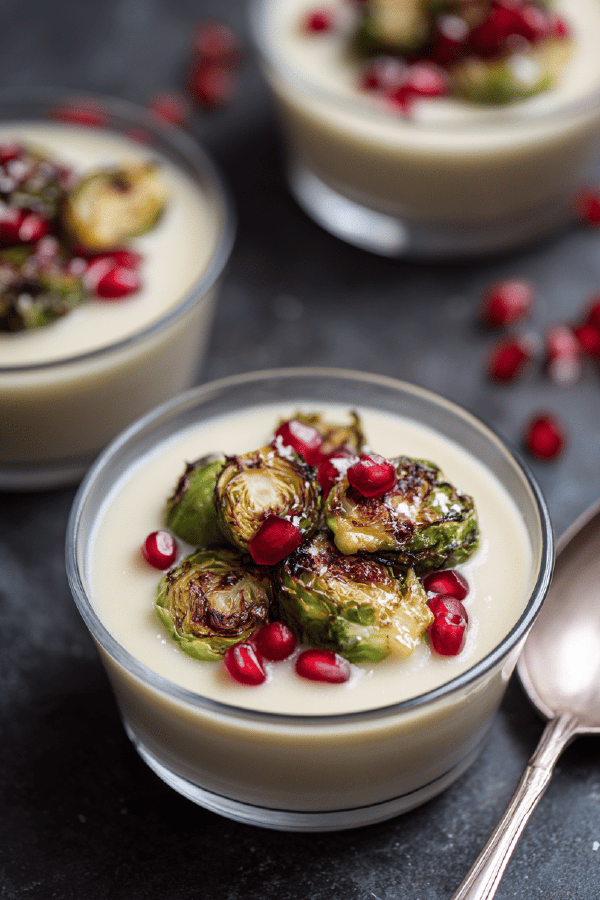Featured Recipe
Cauliflower Cream Verrines

By Kate
"
A creamy cauliflower soup served as individual verrines with a roasted Brussels sprout garnish and fresh seeds. Uses subtle swaps like parsnip and vegetable broth instead of potato and chicken stock. Roasting sprouts adds a crisp, caramelized texture balancing the silken soup. The recipe highlights essential cooking cues to catch doneness by sight and touch. A few twists on ingredients and steps introduce new aromas and texture layers without overcomplicating the process. Efficient, straightforward, and adaptable for gluten and egg-free diets.
"
Prep:
35 min
Cook:
25 min
Total:
Serves:
2 dozens
French-inspired
soup
vegetarian
appetizer
Introduction
Cauliflower cream, not just simple soup, but peeled, par-cooked, and emulsified. The goal is silkiness without heaviness, so keep an eye on texture, don’t let it turn gluey. Parsnip instead of potato here adds subtle sweetness and a touch less starch. Vegetables simmered in milk and broth give body, not just water. The onion and celery base lays the foundation, not much work but essential. While the soup simmers, Brussels sprouts are roasted to bring bitterness and crunch—necessary counterpoint to a creamy, soft soup. Pomegranate seeds offer bursts of freshness and acidity, cutting through richness. The key — keep components separate till plating and watch roasting closely. You want their skin crisp, edges browned, not burned. If you skip roasting and use raw sprouts, the dish falls flat.
Ingredients
About the ingredients
Swapped potato with parsnip for a less starchy, sweeter undertone that doesn’t weigh down the soup. Chicken broth replaced by vegetable broth to keep it vegetarian-friendly but still flavorful; well-made vegetable broth can add complexity, though store-bought is fine in a pinch. Butter remains for richness, but reduced slightly to allow the olive oil in garnish a chance to shine without overwhelming. Onion and celery form the basic mirepoix for foundational aromatics. For garnish, shaved raw Brussels leaves roast quickly and evenly—avoid whole sprouts which take longer to cook through and won’t crisp as well. Pomegranate seeds are a simple, brilliant hack for acidity and texture contrast; fresh or frozen both work but fresh pops best. Olive oil drizzle finalizes with silkiness and slight fruitiness, choose a decent quality one. If no parsnip, use a small peeled carrot or stick to potato but reduce amount slightly to prevent heaviness.
Method
Technique Tips
Start by sweating aromatics in butter; don’t rush or brown prematurely. Softness indicated by onions turning translucent and celery giving a mild crunch fade; smells develop here. Adding all liquids with vegetables and bringing to full boil is to fully integrate flavors quickly, then reduce for gentle cooking. Check vegetable tenderness by piercing cauliflower to avoid overcooking which can turn puree gluey and dull flavors. Seasoning before blending ensures salt evenly distributed; adjusting after blending too often results in uneven seasoning pockets. Blender in batches avoids overheating and uneven blending. Return to pot on lowest heat; keep stirring gently to maintain temperature without breaking emulsion. Brussels leaves roast at high but not max heat to caramelize sugars, feel edges curling and hear light crackle for doneness, roughly 10 minutes. Toss once halfway to prevent burning spots; don’t overcrowd pan or sprout leaves steam then lose crispness. Assembly last second prevents sogginess. Serve warm, not hot, so garnishes retain textures. If soup cools, reheat gently with frequent stirring, do not boil again or texture collapses. Use wide-mouthed glasses or verrines for easy tasting and elegant layering.
Chef's Notes
- 💡 Onions translucent; smell sweet aroma. Don’t rush. Medium heat, butter foams. No browning; keep it gentle. Diced parsnip adds sweetness instead of potato. Subtle touch.
- 💡 Check cauliflower after 15 minutes. Fork tender. Not mushy. Overcooked puree turns gluey. You want velvety, coating spoon. Stir before seasoning. Distribute flavors evenly.
- 💡 Parchment paper ensures even roasting hear crackling sound. Toss Brussels; salt, pepper coat evenly. Crispy edges; no burning. Flip halfway; don’t overcrowd. Space keeps them crisp.
- 💡 Taste balance after blending. Re-season if needed. Remove air bubbles for velvety texture. Check with spoon. Too thick? Add warm broth to adjust creaminess.
- 💡 For garnish, avoid overcooked veggies. Crisp leaves contrast soft soup. Pomegranate bursts freshness. Drizzle olive oil before serving; rich promotes silky mouthfeel.
Kitchen Wisdom
What if it isn’t creamy enough?
Blend longer. More broth helps. Mix textures right. Adjust seasoning as needed during blending.
Can I use other vegetables?
Yes, carrots or squash work well. Adjust cooking times. Keep an eye on tenderness for those too.
How to store leftovers?
In airtight container; keep in fridge. Reheat gently. Don’t boil again. Watch texture; too much heat ruins it.
What if Brussels don’t crisp?
Oven too low. Increase temp. Spread evenly on pan. Too crowded? Steam forms. Give them space to breathe.



